Match the statements in Column I labeled as (a), (b), (c ), and (d) with those in column II labeled as (p), (q), (r ), and (s). Any given statement in column I can have correct matching with one or more statements in Column II.
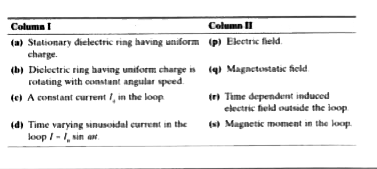
The correct Answer is:A, B, C, D
Topper's Solved these Questions
- MAGNETIC FIELDS DUE TO CURRENTSBOOK - RESNICK AND HALLIDAYCHAPTER - MAGNETIC FIELDS DUE TO CURRENTSEXERCISE - Practice Question (Integer Type)
4 Videos
- MAGNETIC FIELDS DUE TO CURRENTSBOOK - RESNICK AND HALLIDAYCHAPTER - MAGNETIC FIELDS DUE TO CURRENTSEXERCISE - Practice Question (Linked Comprehension)
16 Videos
- INTERFERENCE AND DIFFRACTION BOOK - RESNICK AND HALLIDAYCHAPTER - INTERFERENCE AND DIFFRACTION EXERCISE - PRACTICE QUESTIONS (Integer Type)
6 Videos
- MAGNETIC FORCEBOOK - RESNICK AND HALLIDAYCHAPTER - MAGNETIC FORCEEXERCISE - Practice Questions (Integer type )
7 Videos
Similar Questions
Match the statements in Column I labelled as a,b,c, and d with those in Column II labelled as p,q,r, and s. Any given statement in column I can have correct matching with one or more statements in Column II

View SolutionIn each of the following questions, statements are given in two columns, which have to be matched. The statements in Column I are labelled as (A), (B), (C) and (D), while those in Column II are labelled as (P), (Q), (R), (S) and (T). Any given statement in Column I can have correct matching with one or more statements in Column II.
Match the cations with their properties.

View Solution
Knowledge Check
This section contains 2 questions. Each questions contains statements given in two columns, which have to be matched. The statements in Column I are labelled A, B, C and D, while the statements in Column II are labelled p, q, r, s and t. Any given statement in Column I can have correct matching with one or more statement(s) in Column II. The appropriate bubbles corresponding to the answers to these questions have to be darkened as illustrated in the following example :
If the correct matches are A – p, s and t, B – q and r , C – p and q, and D – s and t, then the correct darkening of bubbles will look like the following
Column II gives certain systems undergoing a process. Column I suggests changes in some of the parameters related to the system. Match the statements in Column I to the appropriate process(es) from Column II.AColumn I(P)Column II(A)The energy of the system is Increased(P)System : A capacitor initially uncharged Increased Process: It is connected to a batteryBColumn I(P)Column II(A)Mechanical energy is provided to the system, which is converted into energy of random motion of its parts (Q)System : A gas in an adiabatic container fitted with an adiabatic piston Process : The gas is compressed by pushing the pistonCColumn I(P)Column II(A)Internal energy of the system is converted into its mechanical energy.(R)System : a gas in a rigid container Process : The gas gets cooled due to colder atmosphere surrounding itDColumn IColumn II(A)Mass of the system is decreased(S)System : A heavy nucleus initially at rest Process : The nucleus fissions into two fragments of nearly equal masses and some neutrons are emitted
In each of the following questions, statements are given in two columns, which have to be matched. The statements in Column I are labelled as (A), (B), (C) and (D), while those in Column II are labelled as (P), (Q), (R), (S) and (T). Any given statement in Column I can have correct matching with one or more statements in Column II.
Match the change observed with the reaction

View SolutionIn each of the following questions, statements are given in two columns, which have to be matched. The statements in Column I are labelled as (A), (B), (C) and (D), while those in Column II are labelled as (P), (Q), (R), (S) and (T). Any given statement in Column I can have correct matching with one or more statements in Column II.
Match the reaction with the type of change.
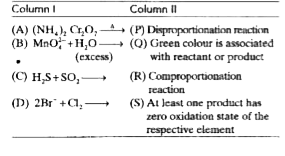
View SolutionIn each of the following questions, statements are given in two columns, which have to be matched. The statements in Column I are labelled as (A), (B), (C) and (D), while those in Column II are labelled as (P), (Q), (R), (S) and (T). Any given statement in Column I can have correct matching with one or more statements in Column II.
Match the radical with the associated change during analysis.
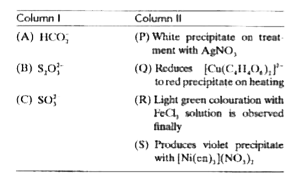
View SolutionIn each of the following questions, statements are given in two columns, which have to be matched. The statements in Column I are labelled as (A), (B), (C) and (D), while those in Column II are labelled as (P), (Q), (R), (S) and (T). Any given statement in Column I can have correct matching with one or more statements in Column II.
Match the change observed during the analysis of the cation
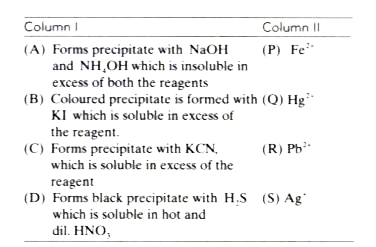
View SolutionIn each of the following questions, statements are given in two columns, which have to be matched. The statements in Column I are labelled as (A), (B), (C) and (D), while those in Column II are labelled as (P), (Q), (R), (S) and (T). Any given statement in Column I can have correct matching with one or more statements in Column II.
Match the change observed during analysis of the radical.
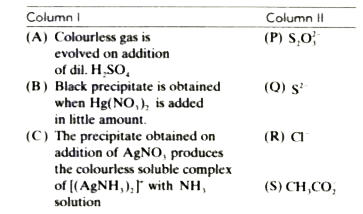
View SolutionIn each of the following questions, statements are given in two columns, which have to be matched. The statements in Column I are labelled as (A), (B), (C) and (D), while those in Column II are labelled as (P), (Q), (R), (S) and (T). Any given statement in Column I can have correct matching with one or more statements in Column II.
Match the radical with the change observed on qualitative analysis
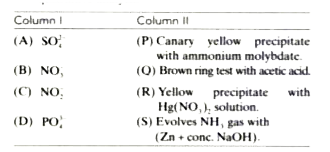
View SolutionIn each of the following questions, statements are given in two columns, which have to be matched. The statements in Column I are labelled as (A), (B), (C) and (D), while those in Column II are labelled as (P), (Q), (R), (S) and (T). Any given statement in Column I can have correct matching with one or more statements in Column II.
Match the compound with the change observed on qualitative analysis
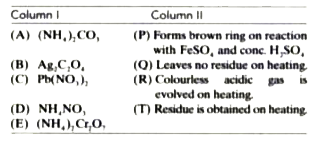
View Solution
